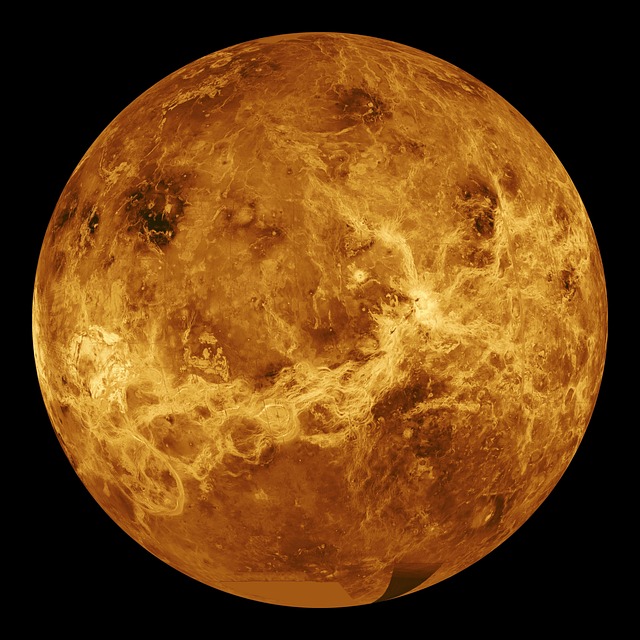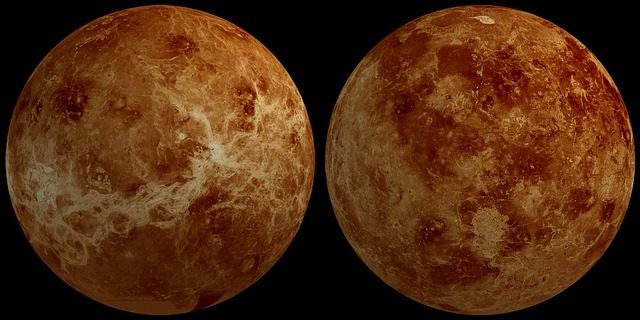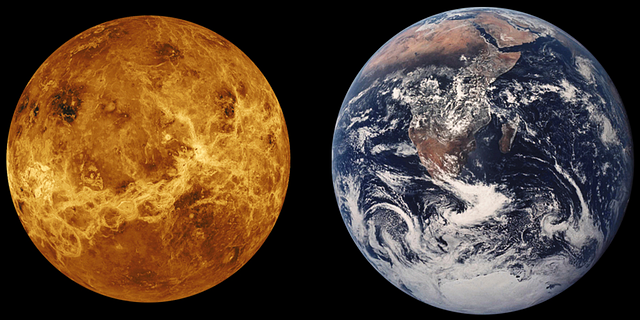Welcome to a journey through the mysteries of Venus, our neighbouring planet in our solar system. As the second planet from the Sun and the closest to Earth, Venus has always captivated our curiosity with its similarities and differences. In this article, we will delve into the geology and surface features of Venus, providing you with an in-depth understanding of this fascinating planet.
Despite being the brightest object in our night sky after the Moon, Venus remains a largely unexplored planet due to its thick atmosphere and extreme conditions. However, through the efforts of various space missions, we have been able to uncover some of its secrets and gain valuable insights into its geology and surface features.
In this article, we will take a closer look at the history of Venus exploration, the geological characteristics that make it unique, its surface features, atmosphere, and the challenges of exploring this hostile planet. By the end, you will have a better understanding of Venus and its place in our solar system.
Table of Contents
History and Exploration of Venus
Venus, often referred to as Earth’s “sister planet”, has long been a subject of fascination for astronomers and scientists. Located just 41 million kilometres away from us, Venus is the second planet from the Sun and the closest one to Earth. With its similar size and proximity to our planet, studying Venus can provide valuable insights into the formation and evolution of both planets. In this article, we will take an in-depth look at the geology and surface features of Venus, shedding light on its unique characteristics and the challenges of exploring it.

The first recorded observations of Venus date back to ancient civilizations, including the Babylonians, Egyptians, and Greeks. These early astronomers noted Venus’ bright appearance and its ability to appear both as a morning and evening star, leading to its identification as the Roman goddess of love and beauty. However, it wasn’t until the 17th century that scientists started making more detailed observations of the planet.
One of the main challenges of studying Venus is its thick and opaque atmosphere. Unlike other planets in our solar system, Venus has a dense carbon dioxide atmosphere that traps heat and creates a runaway greenhouse effect, resulting in surface temperatures of over 450 degrees Celsius (850 degrees Fahrenheit). This extreme temperature, combined with the planet’s high atmospheric pressure, makes it a hostile environment for exploration.
Despite these challenges, several space missions have ventured to Venus to study its geology and surface features. The first mission to successfully reach Venus was the Soviet Union’s Venera 1 in 1961, followed by the American Mariner 2 in 1962. These early missions revealed a rocky, cratered surface with no signs of water or life. In the following years, more advanced missions such as Venera 9 and 10 in 1975 and the Magellan probe in 1989, provided detailed maps of the planet’s surface and revealed its high volcanic activity.
The geological characteristics of Venus are also quite fascinating. With a diameter of 12,104 km, Venus is slightly smaller than Earth but has a similar composition and density. Unlike Earth, Venus does not have plate tectonics, meaning its surface doesn’t have large, moving pieces like our planet’s continents. Instead, the surface is dominated by large, shield volcanoes and extensive lava flows. Theories suggest that this could be due to Venus’ slower rotation and its thick, immobile lithosphere.
One of the most distinctive features of Venus’ surface are its massive volcanoes, including the largest volcano in the solar system, Maat Mons. These volcanoes are thought to be responsible for the planet’s resurfacing and the formation of its unique features such as coronae, which are circular geological formations caused by upwellings of hot material from the planet’s mantle.
In addition to volcanoes, Venus also has a high number of impact craters. These are formed by meteoroids hitting the planet’s surface and are often used to determine the age of the surface. The largest known crater on Venus is Mead crater, measuring around 280 kilometres in diameter.
Continuing to explore the surface is crucial for understanding the planet’s past and its potential for future exploration. Recent missions, such as Europe’s Venus Express and Japan’s Akatsuki, have provided new insights into Venus’ atmosphere and surface features. With advancements in technology, we can expect to learn even more about this mysterious planet and its fascinating geology in the years to come.
Geology of Venus
Venus is often referred to as Earth’s sister planet due to its similar size and composition. However, when it comes to geology, Venus stands out with its unique characteristics and features. In this section, we will take a closer look at the geology of Venus and explore how it differs from Earth.
Size, Composition, and Density:
Venus is the second planet from the Sun and is slightly smaller in size compared to Earth. It has a diameter of approximately 12,104 kilometres, making it the sixth largest planet in our solar system. In terms of composition, it is primarily made up of rock and metal, similar to Earth. However, its atmosphere is composed of mainly sulfuric acid clouds, making it incredibly different from our planet. Venus has a high density, which indicates that it is mostly made up of rocky material.
Tectonics and Plate Tectonics:
One of the most significant differences between Venus and Earth is the lack of plate tectonics on Venus. While Earth’s crust is divided into tectonic plates that constantly move and cause earthquakes and volcanic eruptions, Venus’ crust does not exhibit this activity. This is due to the thicker lithosphere, which prevents the movement of tectonic plates. However, there is evidence of past tectonic activity on Venus, including large rift zones and crustal deformation.
Formation of Surface Features:
The surface is characterized by its vast mountains and volcanoes, many of which are larger than those found on Earth. Theories suggest that these features were formed by a combination of volcanic activity and tectonic processes. Unlike Earth, there is no evidence of plate tectonics on Venus, so the formation of its surface features is still a topic of ongoing research. Some scientists believe that Venus may have experienced a massive resurfacing event, erasing any previous tectonic activity and leaving behind a relatively young, smooth surface.
Impact Craters:
Similar to other rocky planets in our solar system, Venus has a significant number of impact craters on its surface. However, they are not as prominent as those found on the Moon or Mercury. This is due to Venus’ thick atmosphere, which causes smaller meteoroids to burn up before reaching the surface. The largest impact crater is Mead crater, which measures 280 kilometres in diameter. Its smooth surface indicates that it may have been resurfaced by volcanic activity.
In conclusion, Venus may have a similar size and composition to Earth, but its geology sets it apart from all other planets in our solar system. The lack of plate tectonics and the presence of massive volcanoes and impact craters make it a fascinating subject for geological research. With ongoing missions and advancements in technology, we can continue to unravel the mysteries of this intriguing planet and gain a better understanding of its geology.

Surface Features
Venus, also known as the “morning star” or the “evening star”, is often called Earth’s twin due to its similar size and mass. However, upon closer inspection, the surface of Venus is vastly different from our own planet.
Prominent Surface Features:
One of the most striking features of Venus is its massive volcanoes. In fact, Venus has the largest volcano in the solar system called Maat Mons, which stands at a height of 8.8 kilometres and has a diameter of 400 kilometres. Other prominent features include impact craters, which are circular depressions caused by the impact of meteoroids or comets. These craters can range in size from a few kilometres to over 280 kilometres in diameter.
Unique Characteristics of Venus’ Surface:
Unlike Earth, Venus has no oceans, lakes, or rivers. This is due to its extremely hot and dry surface, which is inhospitable to liquid water. However, there is evidence that Venus may have had water in its past, as seen in its numerous dry river beds and valleys. Another unique characteristic of Venus’ surface is its lack of plate tectonics. Unlike Earth, Venus has no movement of its crust, which leads to the formation of continents and oceanic ridges. Instead, Venus is dominated by a single tectonic plate, which covers the entire planet.
Formation of Surface Features:
Scientists have proposed various theories to explain the formation of Venus’ surface features. The most widely accepted theory is that of volcanism, where molten lava from the planet’s interior oozed out onto its surface and solidified. This process is still ongoing on Venus, as seen in the volcanic activity observed by spacecraft.
Other theories suggest that Venus’ surface features were formed due to tectonic activity, similar to Earth’s. However, as mentioned earlier, Venus lacks the necessary conditions for plate tectonics to occur. Another intriguing theory is that Venus’ surface was shaped by a series of catastrophic events, such as large asteroid impacts and massive volcanic eruptions.
Atmosphere and Climate’s Impact on Surface Features:
The thick atmosphere of Venus, consisting mainly of carbon dioxide, plays a significant role in shaping the planet’s surface. The dense atmosphere traps heat from the sun, leading to extreme temperatures on the surface, with an average temperature of 864 degrees Fahrenheit. This extreme heat can cause rocks to melt and reshape the surface.
Additionally, the atmosphere of Venus is known for its fast-moving winds, with speeds reaching up to 360 kilometres per hour. These winds can cause erosion and shape the planet’s surface features. The sulfuric acid clouds in the atmosphere also contribute to the harsh environment on Venus, causing acid rain and corroding the surface.
Exploration of the Surface:
Despite the challenges posed by Venus’ thick atmosphere and extreme conditions, several space missions have successfully explored the planet’s surface. These missions include the Soviet Union’s Venera program and NASA’s Magellan spacecraft, which used radar imaging to map the planet’s surface. The most recent missions, Europe’s Venus Express and Japan’s Akatsuki, have provided new insights into the surface features, including evidence of recent volcanic activity.
Atmosphere and Climate
Venus, the second planet from the sun, has a thick and toxic atmosphere that makes it one of the most inhospitable places in our solar system. Its atmosphere is composed almost entirely of carbon dioxide, with trace amounts of other gases such as nitrogen, sulphur dioxide, and water vapor. Additionally, the atmospheric pressure on Venus is over 90 times that of Earth’s, which is equivalent to being almost a kilometre deep in the ocean.
Extreme Conditions:
The atmosphere of Venus creates an extreme environment on its surface, with temperatures reaching up to 864 degrees Fahrenheit (462 degrees Celsius). This is hot enough to melt lead and is the hottest temperature recorded on any planet in our solar system. The thick atmosphere also traps heat, creating a runaway greenhouse effect, making Venus the hottest planet in our solar system despite not being the closest to the sun.
The extreme conditions on Venus are due to its proximity to the sun and its thick atmosphere. The planet’s slow rotation, taking 243 Earth days to complete one day, also contributes to the extreme temperatures. This slow rotation causes the planet’s atmosphere to circulate much slower than Earth’s, resulting in a lack of temperature variations across Venus’ surface.

The Greenhouse Effect:
The thick atmosphere of Venus plays a crucial role in creating its extreme climate. The carbon dioxide in the atmosphere traps heat and prevents it from escaping into space, creating a greenhouse effect. This phenomenon is similar to what is happening on Earth, but on a much larger scale.
The greenhouse effect is so powerful that it has caused the planet’s surface temperature to rise significantly, making it a hostile environment for any form of life. However, scientists believe that Venus may have had a different climate in the past, with some evidence suggesting that liquid water may have existed on its surface. This has led to theories that Venus may have undergone a runaway greenhouse effect at some point in its history, causing it to become the scorching planet it is today.
Atmospheric Phenomena:
Aside from extreme temperatures and pressure, Venus’ atmosphere is also known for its fast-moving winds and thick clouds of sulfuric acid. The winds on Venus can reach speeds of up to 220 miles per hour (360 kilometres per hour), caused by the planet’s slow rotation and strong atmospheric pressure gradient.
The clouds on Venus are also unique, with layers of sulfuric acid that reflect sunlight, giving the planet its bright appearance. These clouds also contribute to the planet’s high albedo, meaning that it reflects a significant amount of sunlight back into space, making it one of the brightest objects in our solar system.
Exploring Venus’ Atmosphere:
Despite the challenges posed by Venus’ extreme atmosphere, scientists have managed to explore and study it using various methods. These include remote sensing techniques, such as radar and infrared imaging, as well as lander missions that have provided valuable data on Venus’ atmospheric conditions.
The most recent missions, such as the European Space Agency’s Venus Express and Japan’s Akatsuki, have helped shed more light on the mysteries of Venus’ atmosphere. They have provided insights into the planet’s atmospheric circulation, weather patterns, and even discovered a possible sign of active volcanism on the planet. In conclusion, the thick atmosphere and extreme conditions make it a challenging and fascinating planet to study. Despite its similarities to Earth, its atmosphere plays a significant role in shaping its climate and surface features. As we continue to explore and learn more about Venus, it may hold the key to understanding the origins and evolution of our own planet’s atmosphere.
Exploration of Venus’ Surface
Exploring the surface of Venus has been a challenging task for scientists and space agencies. With its thick and toxic atmosphere, extreme temperatures, and high pressure, it is not a hospitable place for human exploration. However, despite these challenges, there have been several successful missions that have provided valuable information about the surface of this enigmatic planet. In this section, we will discuss the challenges of exploring Venus’ surface, the methods used to study it, and the latest discoveries made by recent missions.
Challenges of Exploring the Surface:
One of the biggest challenges of exploring Venus’ surface is its dense atmosphere, which is made up of mostly carbon dioxide. This thick layer of gas makes it difficult for spacecraft to safely enter and land on the planet’s surface. Another major challenge is the planet’s extreme temperatures, which can reach up to 864 degrees Fahrenheit (462 degrees Celsius). These conditions are not only challenging for spacecraft but also for the instruments and materials used to build them.
Methods Used to Study the Surface:
Despite these challenges, several methods have been used to study the surface of Venus. One of the most common methods is remote sensing, which involves using instruments and cameras on spacecraft to gather data and images of the planet’s surface. The first successful remote sensing mission to Venus was NASA’s Pioneer Venus Orbiter in 1978. This mission provided valuable information about the planet’s surface features and atmosphere.
Another method used to study Venus’ surface is through lander missions. These are spacecraft that are designed to land on the planet’s surface and collect data directly. The first successful lander mission to Venus was the USSR’s Venera 7 in 1970. It was the first spacecraft to successfully land on another planet and provided the first direct measurements of Venus’ atmosphere.
Latest Discoveries Made by Recent Missions:
In recent years, there have been several successful missions to Venus that have provided new insights into the planet’s surface. In 2006, the European Space Agency’s Venus Express mission discovered an ozone layer in Venus’ atmosphere, which was unexpected since Venus does not have any oxygen-producing organisms. In 2010, Japan’s Akatsuki mission discovered an enormous bow-shaped cloud in Venus’ atmosphere that was created by a phenomenon called a gravity wave.
In 2021, NASA’s Parker Solar Probe mission made a flyby of Venus and captured images of the planet’s surface, revealing new details about its geological features. The spacecraft’s instruments also measured the planet’s magnetic field, providing new insights into its composition and structure.
